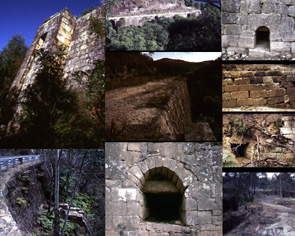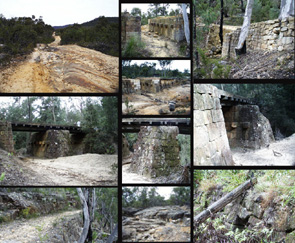


Governor Ralph Darling, who arrived
in 1825, wanted to provide the colony with an all encompassing and
permanent road system, modelled on the Great Roads of England.
The extensive works required for the construction of the descents and
ascents on both sides of the Hawkesbury River, required a large convict
labour force to be stationed there from 1827 - 1832. After Wisemans
Ferry, the road continued north via Mt Manning and Mt McQuoid to
Wollombi. It then branched, with one line to Maitland and another to
Patricks Plains (Singleton).
The road which scaled the precipitous
and mountainous terrain between Wisemans Ferry and Mt Manning, utilised
cut and fill construction on hillsides, creating roads which wound and
zig-zagged on ascents and descents. It required the blasting and
cutting away of rocky spurs, and the construction of the impressive and
durable formations and structures which mark the second and third
construction phases of the Great North Road, such as the ashlar masonry
retaining walls on the ascent of Devines Hill. By 1832 the substantial
structures over the stony mountains, ridges and gorges were mainly
complete and the convicts who had acquired skills in their construction
were shifted to other Great Roads. These were the Great Western Road
(from Sydney to Bathurst and thence Wellington) and the Great South
Road (from Sydney via Goulburn to Yass and the Monaro Plains).


The Great North Road is an item of National
heritage significance. It has values under all relevant heritage
assessment criteria, including historic, aesthetic, scientific and
social significance. The Great North Road is significant for the
following reasons:
It has historic significance as a
signifier of the outlooks of early colonial society. Its magnificent
structures were powerful, tangible symbols of the colony's perceived
place and role in the course of empire, unmistakable evidence that the
civilised state was being attained, and a triumph over the rugged and
inhospitable landscape separating the centre of Sydney from the "garden
of the colony", the Hunter Valley.
The Great North Road is associated
with several notable figures in colonial administration, surveying and
engineering, including Governor Ralph Darling; Surveyor-General Sir
Thomas Mitchell, Heneage Finch and Percy Simpson. Prior to its
selection and survey by Europeans, much of the route which later became
the Great North Road, was in use as an Aboriginal route linking the tribal groups of the Hunter Region to the Hawkesbury.
Individual structures found along the Great North Road are aesthetically attractive.
Structures such as the Devines Hill buttressed retaining wall and items
such as Clares Bridge and Circuit Flat Bridge have aesthetic value in
their design, execution and siting. Some of these structures are shown
on this page.
The Great North Road has historical archaeological
significance in that it physically demonstrates the work patterns,
skills and organisation of the convict road gangs, particularly through
the distribution and configuration of the stone retaining walls,
drainage structures and bridges. This evidence is unavailable in
documentary sources and has been essential in changing our historical
views on convicts in road gangs. The Road may be considered a museum of convict work, graphic in its demonstration of the difficulty, laboriousness and isolation of 1830s road building.
The Great North Road has historic / scientific value in its
demonstration of the standards and practice of road engineering in the
colony during the "Great Roads" period of the late 1820s and 1830s, and
records the importation and adaptation of the (then) recent
road-building revolution in England. This essential information is
unavailable in documentary sources, and as such it has changed our
understanding of Australia's road engineering history.
Many precincts of the Road still demonstrate the nature of nineteenth century travel,
through their early style geometry and layout, including sight-lines
and tight curves, and with structures passing through the original
landscape and vegetation.
Specific associated sites and items along the Great North Road are significant for their archaeological research potential.
This includes for example, the various convict road station (stockade)
sites such as those at Wisemans Ferry and on Devines Hill, the hut site
at Frog Hollow and the former property of Heneage Finch at Laguna.

| The CONVICT TRAIL PROJECT: Caring For the Great North Road |